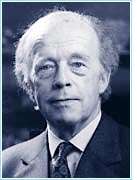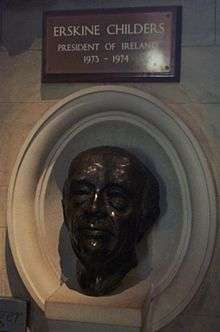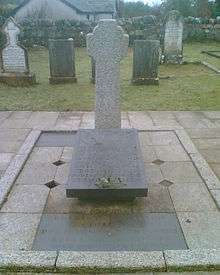Erskine Hamilton Childers
Erskine Hamilton Childers (11 December 1905 – 17 November 1974) was an Irish Fianna Fáil politician who served as the fourth President of Ireland from June 1973 to November 1974. He is the only Irish president to have died in office. He also served as Tánaiste and Minister for Health from 1969 to 1973, Minister for Transport and Power from 1959 to 1969, Minister for Posts and Telegraphs from 1951 to 1954 and 1966 to 1969, Minister without portfolio in July 1959, Minister for Lands from 1957 to 1959 and Parliamentary Secretary to the Minister for Local Government from 1944 to 1948. He served as a Teachta Dála (TD) from 1938 to 1973.[1]
Erskine Hamilton Childers | |
|---|---|
 | |
| 4th President of Ireland | |
| In office 25 June 1973 – 17 November 1974 | |
| Taoiseach | Liam Cosgrave |
| Preceded by | Éamon de Valera |
| Succeeded by | Cearbhall Ó Dálaigh |
| Tánaiste | |
| In office 2 July 1969 – 14 March 1973 | |
| Taoiseach | Jack Lynch |
| Preceded by | Frank Aiken |
| Succeeded by | Brendan Corish |
| Minister for Health | |
| In office 2 July 1969 – 14 March 1973 | |
| Taoiseach | Jack Lynch |
| Preceded by | Seán Flanagan |
| Succeeded by | Brendan Corish |
| Minister for Transport and Power | |
| In office 27 June 1959 – 2 July 1969 | |
| Taoiseach |
|
| Preceded by | Office created |
| Succeeded by | Brian Lenihan |
| Minister for Posts and Telegraphs | |
| In office 10 November 1966 – 2 July 1969 | |
| Taoiseach | Jack Lynch |
| Preceded by | Joseph Brennan |
| Succeeded by | Patrick Lalor |
| In office 13 June 1951 – 2 June 1954 | |
| Taoiseach | Éamon de Valera |
| Preceded by | James Everett |
| Succeeded by | Michael Keyes |
| Minister for Lands | |
| In office 27 March 1957 – 23 July 1959 | |
| Taoiseach | Éamon de Valera |
| Preceded by | Mícheál Ó Móráin |
| Succeeded by | Joseph Blowick |
| Minister without portfolio | |
| In office 23 July 1959 – 28 July 1959 | |
| Taoiseach | Éamon de Valera |
| Preceded by | New office |
| Succeeded by | Office abolished |
| Parliamentary Secretary to the Minister for Local Government | |
| In office 19 July 1944 – 4 May 1948 | |
| Taoiseach | Éamon de Valera |
| Preceded by | New office |
| Succeeded by | Office abolished |
| Teachta Dála | |
| In office October 1961 – 23 June 1973 | |
| Constituency | Monaghan |
| In office February 1948 – October 1961 | |
| Constituency | Longford–Westmeath |
| In office June 1938 – February 1948 | |
| Constituency | Athlone–Longford |
| Personal details | |
| Born | Erskine Hamilton Childers 11 December 1905 Westminster, London, England |
| Died | 17 November 1974 (aged 68) Phibsborough, Dublin, Ireland |
| Cause of death | Heart failure |
| Resting place | Roundwood, County Wicklow, Ireland |
| Nationality | Irish |
| Political party | Fianna Fáil |
| Spouse(s) |
|
| Children | 7, including Erskine Barton and Nessa |
| Parents | |
| Alma mater | Trinity College, Cambridge |
| Profession |
|
| Signature | |
His father Robert Erskine Childers, a leading Irish republican and author of the espionage thriller The Riddle of the Sands, was executed during the Irish Civil War.
Early life
Childers was born in the Embankment Gardens, Westminster, London,[2] to a Protestant family, originally from Glendalough, Ireland. Although also born in England, his father, Robert Erskine Childers, had an Irish mother and had been raised by an uncle in County Wicklow, and after the First World War took his family to live there. His mother, Mary Alden Childers was a Bostonian whose ancestors arrived on the Mayflower. Robert Erskine Childers and his wife, Mary, later emerged as prominent and outspoken Irish Republican opponents of the political settlement with Britain, which resulted in the establishment of the Irish Free State.[3] Childers was educated at Gresham's School, Holt,[4][5] and the University of Cambridge, hence his British upper class accent. In 1922, when Childers was sixteen, his father was executed by the new Irish Free State on politically-inspired charges of gun-possession. The pistol he had been found with had been given to him by Michael Collins. Before his execution, in a spirit of reconciliation, the elder Childers obtained a promise from his son to seek out and shake the hand of every man who had signed his death warrant.[6] After attending his father's funeral, Childers returned to Gresham's,[5] then two years later he went on to Trinity College, Cambridge.[7]
Career
After finishing his education, Childers worked for a period for a tourism board in Paris. In 1931, Éamon de Valera invited him to work for de Valera's recently founded newspaper The Irish Press in Dublin, where Childers became advertising manager.[8] He became a naturalised Irish citizen in 1938. That same year, he was elected as a Fianna Fáil TD for Athlone–Longford.[9] He would remain as a member of Dáil Éireann until 1973, when he resigned to become President of Ireland.
When former President of Ireland Douglas Hyde died in 1948, de Valera and his Fianna Fáil colleagues, then in opposition, stood, alongside most of the cabinet (with the exception of Noël Browne who endeavoured to venture in), outside St. Patrick's Cathedral while the funeral was going on. They sent Childers, a fellow Protestant, into the cathedral as their representative.[10]
Childers joined the cabinet in 1951, as Minister for Posts and Telegraphs in the de Valera government. He then served as Minister for Lands in de Valera's 1957–59 cabinet; as Minister for Transport and Power under Seán Lemass; and, successively, as Transport Minister, Posts and Telegraphs Minister, and Health Minister under Jack Lynch. He became Tánaiste in 1969.
Childers period as a Minister was controversial. One commentator described his ministerial career as "spectacularly unsuccessful." Others praised his willingness to make tough decisions. He was outspoken in his opposition to Charles Haughey, in the aftermath of the Arms Crisis, when Haughey and Neil Blaney, having been both removed from the government, were sent for trial amid allegations of a plot to import arms for the Provisional IRA. (Both were acquitted.)
President of Ireland
Campaign
Fine Gael TD Tom O'Higgins had come within 11,000 votes (1%) of defeating de Valera in the 1966 presidential election; he was widely expected to win the 1973 election, when he was again the Fine Gael nominee. Childers was nominated by Fianna Fáil at the behest of de Valera, who pressured Jack Lynch in the selection of the presidential candidate. He was a controversial nominee, owing not only to his British birth and upbringing but to his Protestantism. However, on the campaign trail his personal popularity proved enormous, and in a political upset, Childers was elected the fourth President of Ireland on 30 May 1973, defeating O'Higgins by 635,867 (52%) votes to 578,771 (48%).
Presidency
Childers was inaugurated as President of Ireland, but he chose to take his oath of office in the Irish language with some reluctance. His very distinctive Oxbridge accent made pronouncing Irish difficult, so it was written down on a large board for him phonetically to help him with this.
Childers, though 67, quickly gained a reputation as a vibrant, extremely hard-working President, and became highly popular and respected. However, he had a strained relationship with the incumbent government, led by Taoiseach Liam Cosgrave of Fine Gael. Childers had campaigned on a platform of making the presidency more open and hands-on, which Cosgrave viewed as a threat to his own agenda as head of government. He refused to co-operate with Childers' first priority upon taking office, the establishment of a think tank within Áras an Uachtaráin, to plan the country's future. Childers considered resigning from the presidency, but was convinced to remain by Cosgrave's Foreign Minister, Garret FitzGerald.[11] However, Childers remained detached from the government; whereas previously, Presidents had been briefed by the Taoiseach once a month, Cosgrave briefed President Childers and his successor, Cearbhall Ó Dálaigh, on average once every six months.
Though frustrated about the lack of power he had in the office,[11] Childers' daughter Nessa believes that he played an important behind-the-scenes role in easing the Northern Ireland conflict, reporting that former Prime Minister of Northern Ireland Terence O'Neill met secretly with her father at Áras an Uachtaráin on at least one occasion.[12]
Death
Prevented from transforming the presidency as he desired, Childers instead threw his energy into a busy schedule of official visits and speeches, which was physically taxing.
On 17 November 1974, during a conference to the psychiatrists of the Royal College of Physicians in Dublin, Childers suffered a congestional heart failure causing him to lie sideways and turn blue before suddenly collapsing. He was pronounced dead the same day at Mater Misericordiae University Hospital.
Childers's state funeral in St. Patrick's Cathedral, Dublin, was attended by his presidential predecessor Éamon de Valera and world leaders including the Earl Mountbatten of Burma (representing Queen Elizabeth II), the British Prime Minister Harold Wilson and British Opposition Leader Edward Heath, and Presidents and crowned heads of state from Europe and beyond. He was buried in the grounds of the Church of Ireland Derralossary Church, in Roundwood, County Wicklow.
 Memorial to Erskine Childers in St. Patrick's Cathedral |
 Erskine Childers' grave in Derralossary Church grounds, Roundwood, County Wicklow, Ireland |
.jpg) Close up view of Erskine Childers' grave in Derralossary Church grounds, Roundwood, County Wicklow, Ireland |
Succession
Childers's widow, Rita Childers, shared her late husband's widespread personal popularity. Upon his death, when she issued a press statement pleading for the nation to keep the office above politics in choosing a successor, Cosgrave reacted by suggesting to the Opposition Leader, Jack Lynch, that they appoint Mrs. Childers to the presidency by acclamation. Lynch agreed four days after Childers' death to bring the suggestion to his party. However, when members of Cosgrave's Fine Gael disclosed the plan to the press on their own initiative, Lynch, believing his Fianna Fáil party was being denied a public voice in the decision, he withdrew his support for her.[13]
All parties instead agreed to appoint the former Attorney General and Chief Justice, Cearbhall Ó Dálaigh, as Childers' successor.
Family
Childers married Ruth Ellen Dow in 1925. They had five children, Ruth Ellen Childers, born in July 1927, Erskine, born in March 1929, followed by Roderick Winthrop Childers in June 1931, and in November 1937 twin daughters, Carainn and Margaret Osgood Childers. After the death of Dow in 1950, Childers married again, in 1952, to Rita Dudley. Together they had a daughter, Nessa, who is a former Member of the European Parliament and County Councillor. Childers was survived by children from both his marriages. His second wife Rita Dudley died on 9 May 2010.
See also
- List of people on stamps of Ireland
References
- "Erskine Hamilton Childers". Oireachtas Members Database. Retrieved 30 May 2010.
- Pauric J. Dempsey; Lawrence William White (2009). "Childers, Erskine Hamilton". In James McGuire and James Quinn (ed.). Dictionary of Irish Biography. Royal Irish Academy. ISBN 978-0-521-63331-4.
- Young, John N., Erskine H. Childers, President of Ireland: A Biography (Gerrards Cross and Atlantic Highlands, N.J.: Colin Smythe, 1985, ISBN 978-0-86140-195-6), pp. 5–7
- Young, op. cit., p. 18
- Benson, S. G. G., and Martin Crossley Evans, I Will Plant Me a Tree: an Illustrated History of Gresham's School, (James & James, London, 2002)
- "Books: On Soundings". Time. 8 November 1976. Retrieved 10 January 2013.
- "Notable Alumni". Trinity College Cambridge. Retrieved 10 January 2013.
- "Past Presidents – Erskine Childers". Áras an Uachtaráin website. Retrieved 10 January 2013.
- "Erskine Hamilton Childers". ElectionsIreland.org. Retrieved 25 July 2012.
- "Presidential campaigns are not getting dirtier â€" they are just more public". The Tuam Herald. 26 October 2011.
- Moody, Theodore William; Francis X. Martin; Francis John Byrne; Art Cosgrove (2005). A New History of Ireland, Vol. 7: Ireland, 1921–84. Clarendon Press.
- Diarmaid Ferriter (23 October 2011). "History Show – Erskine Childers' Presidency". RTÉ Radio 1 (Podcast). RTÉ. Retrieved 9 December 2011.
- T. Ryle, Dwyer (2001). Nice Fellow: A Biography of Jack Lynch. Cork: Mercier. pp. 311–312.
Further reading
- John N. Young, Erskine H. Childers: President of Ireland